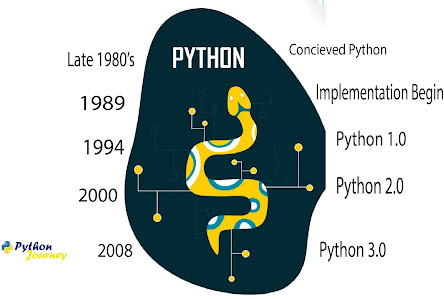History of Python:
Python is a broadly used preferred-purpose, high-level programming language. It was first of all designed by means of Guido van Rossum in 1991 and developed by way of Python Software Foundation. It become mainly evolved for emphasis on code readability, and its syntax allows programmers to express principles in fewer lines of code.
Who invented Python?
Python changed into invented via Guido van Rossum, a Dutch programmer, inside the overdue Eighties. Guido started running on Python as a successor to the ABC language, aiming to cope with a number of its boundaries even as keeping its simplicity and ease of use. He wanted to create a language that turned into powerful yet clean to read, with a trustworthy syntax. Python became first released in 1991, and it speedy won recognition because of its readability, simplicity, and versatility. Guido van Rossum endured to guide the development of Python until he stepped down as the "Benevolent Dictator For Life" (BDFL) in 2018, leaving in the back of a robust and thriving programming language this is widely used across numerous domains today.
Why is the Python Language Called Python?
The Python programming language is known as after the British sketch comedy collection "Monty Python's Flying Circus," which aired at the BBC in the Nineteen Seventies. Guido van Rossum, the creator of Python, became partial to the display and desired a call that was brief, precise, and slightly mysterious. He selected "Python" as a tribute to the comedy group, reflecting the a laugh and playful spirit he desired to infuse into the language. This desire of name has contributed to the way of life of the Python network, which regularly embraces a sense of humor and a lighthearted approach to programming.
Evolution of Python:
Python has come a long way since its introduction by Guido van Rossum in the 1980s.
The first release, Python 0.9.0, was in 1991, and included features such as exception handling, functions, and basic data types that are still basic today with Python 1.0 released in 1994. Functional programming tools like lambda, map, filter, reduce They were introduced.
The release of Python 2.0 in 2000 saw significant improvements in the language such as list logic, garbage collection systems, which marked its wide acceptance.
With the release of Python 3.0 in 2008 was a major change aimed at fixing anomalies and improving readability, but not backwards compatibility with Python 2.
Since then, Python 3 has remained constantly updated, adding powerful features and performance improvements ho, has ensured that Python remains one of the most popular and versatile programming languages today.
Modern Python shows the growth and development of Python since the release of Python 3.0 in 2008. During this time, Python strengthened its position as one of the most popular programming languages in the world.
With Python 3 many improvements were made, such as better Unicode support, more consistent syntax, refined standard library and, addressing many of the limitations of Python 2. Type notations in later versions, asynchronous programming with asynchronous programming, f Strings for formatted strings and characters, enhance the functionality and useability of the language.
Python's versatility has led to its adoption in fields as diverse as web development, data science, artificial intelligence, and automation, supported by a rich ecosystem of libraries and frameworks This continuous improvement ensures that Python remains leading edge a choice for developers, teachers and researchers.
Community and Ecosystem of Python:
Python’s vibrant community and rich ecosystem are key to its success. Developers, educators and enthusiasts around the world contribute to the growth of Python, creating a supportive and collaborative environment.
This community-driven approach led to the creation of many libraries and frameworks, and enhanced Python’s capabilities in web development (Django, Flask), data science (NumPy, pandas), machine learning (TensorFlow, PyTorch), and automation ( Selenium, BeautifulSoup). Extensive features, dynamic conventions, and regular assemblies make Python an accessible and powerful language for a wide range of applications.
Python's Impact:
Python has had a profound impact on human life, reworking industries and normal studies. Its simplicity and versatility have democratized programming, making it available to beginners and permitting speedy improvement of complex applications. In healthcare, Python-powered information analysis and machine studying models beautify disease prognosis and remedy plans. In finance, it streamlines buying and selling algorithms and hazard management. Python's function in net development and automation simplifies business approaches, whilst its application in education equips students with vital programming skills. From powering synthetic intelligence to permitting clinical research, Python maintains to power innovation and enhance satisfactory of life across the globe.
Conclusion:
Python’s journey from a niche scripting language to one of the world’s most popular programming languages is a testament to the versatility, flexibility, and power of its community Its wide range of applications— from web development to automation to data science and machine learning— have revolutionized industries. ensuring that it remains a powerful tool for innovation and problem solving. As we look to the future, Python’s role in advancing technology and improving quality of life will undoubtedly continue to grow, cementing its status as a must-have language for developers and researchers.






.png)




0 Comments